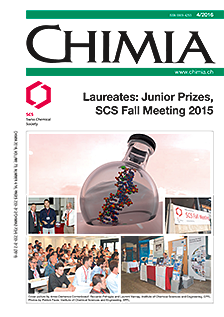Laser Ablation/Ionisation Mass Spectrometry: Sensitive and Quantitative Chemical Depth Profiling of Solid Materials
DOI:
https://doi.org/10.2533/chimia.2016.268Keywords:
Chemical depth profiling, Chemical mapping of heterogeneous materials, High spatial resolution analysis, Laser ablation, Laser ionisation mass spectrometryAbstract
Direct quantitative and sensitive chemical analysis of solid materials with high spatial resolution, both in lateral and vertical direction is of high importance in various fields of analytical research, ranging from in situ space research to the semiconductor industry. Accurate knowledge of the chemical composition of solid materials allows a better understanding of physical and chemical processes that formed/altered the material and allows e.g. to further improve these processes. So far, state-of-the-art techniques such as SIMS, LA-ICP-MS or GD-MS have been applied for chemical analyses in these fields of research. In this report we review the current measurement capability and the applicability of our Laser Ablation/Ionisation Mass Spectrometer (instrument name LMS) for the chemical analysis of solids with high spatial resolution. The most recent chemical analyses conducted on various solid materials, including e.g. alloys, fossils and meteorites are discussed.Downloads
Published
2016-04-27
Issue
Section
Scientific Articles
License
Copyright (c) 2016 Swiss Chemical Society

This work is licensed under a Creative Commons Attribution-NonCommercial 4.0 International License.
How to Cite
[1]
A. Riedo, V. Grimaudo, P. Moreno-García, M. B. Neuland, M. Tulej, P. Broekmann, P. Wurz, Chimia 2016, 70, 268, DOI: 10.2533/chimia.2016.268.







